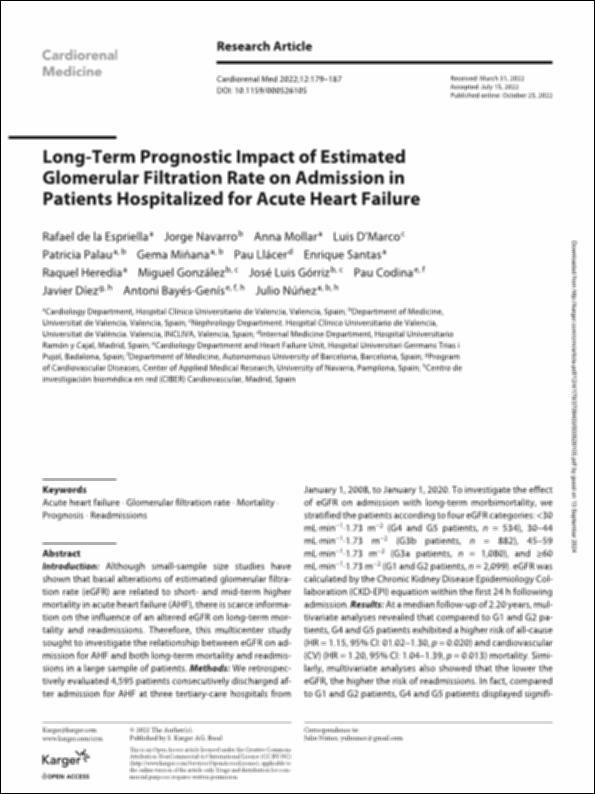Por favor, use este identificador para citar o enlazar este ítem:
http://hdl.handle.net/10637/16163Long-term prognostic impact of estimated glomerular filtration rate on admission in patients hospitalized for acute heart failure
| Título : | Long-term prognostic impact of estimated glomerular filtration rate on admission in patients hospitalized for acute heart failure |
| Autor : | Espriella, Rafael de la Navarro, Jorge Mollar, Anna D'Marco Gascón, Luis Gerardo Palau, Patricia Miñana, Gema Llácer, Pau Santas, Enrique Heredia, Raquel González, Miguel Górriz, José Luis Codina, Pau Díez, Javier Bayés Genís, Antoni Núñez, Julio |
| Materias: | Enfermedad cardiovascular; Cardiovascular diseases; Muerte; Death; Endocrinología; Endocrinology; Paciente; Patients |
| Editorial : | S. Karger AG |
| Citación : | De la Espriella, R., Navarro, J., Mollar, A., D'Marco, L., Palau, P., Miñana, G., Llácer, P., Santas, E., Heredia, R., González, M., Górriz, J.L., Codina, P., Díez, J., Bayés-Genís, A. & Núñez, J. (2022). Long-term prognostic impact of estimated glomerular filtration rate on admission in patients hospitalized for acute heart failure. Cardiorenal Medicine, vol. 12, i. 4 (nov.), pp. 179–188. DOI: https://doi.org/10.1159/000526105 |
| Resumen : | Introduction: Although small-sample size studies have shown that basal alterations of estimated glomerular filtration rate (eGFR) are related to short- and mid-term higher mortality in acute heart failure (AHF), there is scarce information on the influence of an altered eGFR on long-term mortality and readmissions. Therefore, this multicenter study sought to investigate the relationship between eGFR on admission for AHF and both long-term mortality and readmissions in a large sample of patients. Methods: We retrospectively evaluated 4,595 patients consecutively discharged after admission for AHF at three tertiary-care hospitals from January 1, 2008, to January 1, 2020. To investigate the effect of eGFR on admission with long-term morbimortality, we stratified the patients according to four eGFR categories: <30 mL·min−1·1.73 m−2 (G4 and G5 patients, n = 534), 30–44 mL·min−1·1.73 m−2 (G3b patients, n = 882), 45–59 mL·min−1·1.73 m−2 (G3a patients, n = 1,080), and ≥60 mL·min−1·1.73 m−2 (G1 and G2 patients, n = 2,099). eGFR was calculated by the Chronic Kidney Disease Epidemiology Collaboration (CKD-EPI) equation within the first 24 h following admission. Results: At a median follow-up of 2.20 years, multivariate analyses revealed that compared to G1 and G2 patients, G4 and G5 patients exhibited a higher risk of all-cause (HR = 1.15, 95% CI: 01.02–1.30, p = 0.020) and cardiovascular (CV) (HR = 1.20, 95% CI: 1.04–1.39, p = 0.013) mortality. Similarly, multivariate analyses also showed that the lower the eGFR, the higher the risk of readmissions. In fact, compared to G1 and G2 patients, G4 and G5 patients displayed significantly increased incident rate ratios of total all-cause (28%), CV (26%), and HF-related (30%) readmissions. Conclusion: Data from this large study provide evidence that an eGFR below 30 mL·min−1·1.73 m−2 on admission could be an independent predictor for long-term mortality and readmissions in patients with AHF. |
| URI : | http://hdl.handle.net/10637/16163 |
| Derechos: | http://creativecommons.org/licenses/by-nc/4.0/deed.es Open Access |
| ISSN : | 1664-3828 1664-5502 (Electrónico) |
| Fecha de publicación : | nov-2022 |
| Centro : | Universidad Cardenal Herrera-CEU |
| Aparece en las colecciones: | Dpto. Medicina y Cirugía |
Los ítems de DSpace están protegidos por copyright, con todos los derechos reservados, a menos que se indique lo contrario.


